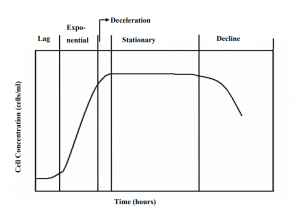Contents:
Phases of Culture Growth during Fermentation
Mammalian cell culture is encountered with various different phases of growth and/or death starting from the point of inoculation of the medium with cell culture until shut-down. The cell population in a batch culture has the following phases of development:
(1)lag phase
(2)logarithmic or exponential growth phase
(3)deceleration phase
(4)stationary phase
(5)death phase
Lag Phase
- The inoculation of cells into fresh medium involves the to accustomed to the new nutrient/growth environment by means of reorganizing their molecular constituents.
- New enzymes are synthesized depending upon the composition of the new medium.
- The synthesis of some other enzymes is repressed, and the internal machinery of cells is adapted
to the new environmental conditions. - These changes reflect the intracellular mechanisms for regulation of the metabolic processes.
- During this phase, the cell mass increases a little while the cell number remains essentially constant.
- However, at times the cell viability of the seeding culture is not high enough, there may be
a pseudo-lag phase. - This phase of arrested growth is not because of the adaptation of cells to new culture environment but due to small inoculum size or poor condition of the inoculum
Exponential Growth Phase
- The cells have adjusted to their new environment and are able to multiply rapidly which is indicated by a steady exponential increase in cell number density with time in the exponential growth phase (logarithmic growth phase)
- The exponential phase is often regarded as a period of balanced growth in which all components of a cell grow at the same rate.
- This means that the average composition of a single cell remains approximately constant during this growth phase. Thus, during balanced growth, the determination of cell number or cell mass of the specific growth rate will be the same. The exponential growth rate follows first-order kinetics
Deceleration Phase
- The growth phase attains a deceleration as there is no subsequent addition of nutrients to the system during the course of its operation, which eventually leads to depletion of one or more essential nutrients.
- As there is no product recovery during the course of the batch either, there may be a gradual build-up of toxic or inhibitory by-products.
- The rapidly changing culture environment results in unbalanced growth which corresponds to the deceleration phase of growth.
- The deceleration phase witnesses the restructuring of the cell to increase the prospects of cell survival in response to the rapidly changing conditions. This phase is short-spanned and is often considered as a continuous process between the exponential and stationary phase rather than as a separate phase by itself.
Stationary Phase
- The cessation of cell division marks the stationary phase which states that the growth rate is equal to the death rate.
- Even though the net growth rate is zero during the stationary phase, cells are still metabolically active and produce secondary metabolites (non-growth related products). In fact, the production of some metabolites is enhanced during the stationary phase (antibodies, hormones, etc.) due to metabolite deregulation.
- During the course of the stationary phase, one or more of the following phenomena may take place:
1. Total cell concentration remains constant while the number of viable cells decreases.
2. Cell lysis is observed and there is a decline in viable cell concentration. A second growth phase may occur as cells may also grow on products of lysed cells (cryptic growth).
3. Cells do not grow in this phase but are metabolically active and produce secondary metabolites as a result of metabolite deregulation. - Reasons attributed to the termination of growth may be either consumption of an essential nutrient or accumulation of toxic products.
- If there is production of an inhibitory product during the course of the batch operation, the growth rate will slow down with the accumulation of that inhibitory substance and above a certain concentration of this inhibitor the growth will cease completely.
- It has been hypothesized in the current work that an exit from stationary phase might be a prerequisite for apoptosis.
Death Phase
- In the death phase or decline phase, there is an overlap between two stages of growth as some cell death may have already started in the stationary phase.
- The rate of death follows first-order kinetics.

